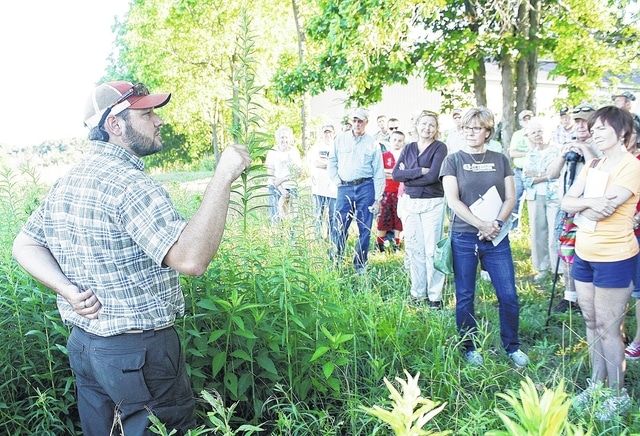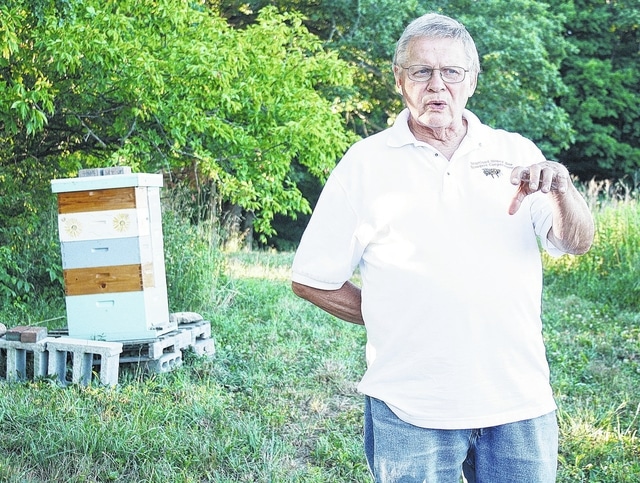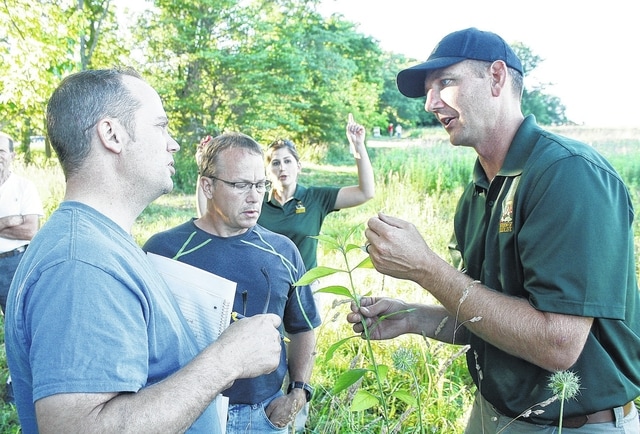


MAPLEWOOD — Creating an environment to satisfy the needs of honeybees to quails to other living creatures was discussed during a wildlife habitat workshop which focused on pollinators Wednesday evening at Jim Scheer’s property in Maplewood.
“There are a lot of other pollinators out there besides bees,” said Mike Retterer, Pheasants Forever. “They can be mammals, reptiles as well as insects.
“Native pollinators are the key the health,” he said.
The pollinator habitat, said Retterer, needs to include lots of flowers and diversity.
“You need to focus on the entire growing season,” he said. “The size and structure of the flowers is also important.”
Honeybees, he said, help pollinate fruit, vegetable and nut trees.
“Native pollinators play a vital role in the economy,” said Retterer. “You can increase farm and ranch income with conservation. A great pollinator habitat equals a good wildlife habitat.”
A pair of nesting birds, he said, will eat many bugs and insects in the course of a 12-day nesting period.
“They bring three bugs per trip and make seven trips per hour,” said Retterer.
During the nesting period, that accounts for 3,000 insects eaten by the birds.
Retterer said a person developing a pollinator habitat should focus on three blooming periods. To create the habitat you need bare open ground, diversity to plants, warm sunlight, good ground cover for pheasant and quail chicks and flowers in lots of different colors and shapes.
“One plant may focus on a lot of species,” said Retterer.
Casey Burdick, Ohio Division of Forestry, continued the discussion on pollinators in the woodlands.
“Thirty-one percent of Ohio is forested,” said Burdick. “We have 21 state forests. Eighty-seven percent of the woods are privately owned.”
Those owners, she said, use the land for hunting, firewood, watch the livestock and “more people are talking about pollinators.”
The edges of the woodlands, she said, are good for pollinators and wildlife.
Some plants/trees that can be planted in the pollinator/wildlife habitats include hazelnut, service berry, dogwood, blackberries, black raspberries and black choke berry.
The interior of the woodland many not have as many food-type sources. It tends to be an egg-laying habitat, she said. Willows, black cherry, black gum and oak are good to plant in this area.
With the ash borer disease, many people have dead trees in the woods, she said.
“It’s time to get rid of them and the honeysuckle and build up your diversity,” said Burdick.
John Kaiser, Ohio Division of Wildlife, said are three “P’s” which are needed to establish a pollination habitat: Planning ahead; Patience; and Persistence.
His five main tips for a successful habitat include site selection, seed selection, site preparation, plowing and planting and maintenance.
“The most vital step is site preparation,” said Kaiser. “Maintenance is the key to sustainability of the habitat This is not a plant it and walk away activity.”
Donnie Knight, U.S. Fish and Wildlife Service, talked about turning old fields and pastures into pollinator habitats. He said wildflower seeds should be planted in the winter on the snow as the seeds need cold weather to start their growth.
“They need to freeze, thaw, freeze, thaw,” said Knight.
The participants visited three field stations to learn about beekeeping and honeybees, wildflower identification and more on the establishment and management of the habitat.
Dwight Wells, of Troy, who is a founding member of Heartland Honey Bee Breeder Cooperative, talked about the importance of honeybees in the U.S.
“One-third of the food we eat is pollinated by honeybees,” said Wells.
In 1954, he started beekeeping as a 4-H project. Farmers and men went out in the fall and got hone.
“Today, 50 percent of the beekeepers are females and families with kids,” he said.
In 2006, the collapse of the honeybee raised concerns throughout the U.S. He said there have been thousands of research papers published about honeybees.
The honeybee, he said, is not native to the United States. When the pilgrims arrived with their trees, they thought there would be bees here to pollinate them. They went back to England and brought honeybees to North America from Europe.
In 1859, three men from Ohio brought over the Italian honeybee to the U.S.
“We need honeybees,” said Wells. “We need people who like honeybees. We have women who have been put through bee school. The next year the husband comes too. One in three kids will become interested in honeybees.”
There are honeybee colonies in New York City, Chicago and Wright Pat Air Force Base in Dayton.
“All plants and seeds have to have pollination,” said Wells. “There are 500 native bees in Ohio but we need honeybees too. There’s a lot of training involved and the more you like biology, the better beekeeper you’ll be.”
Terry Lavy, of Covington, who owns The Conservationist, was also a presenter for the program.
“This is a hot topic right now,” said Jason Jones, an Ohio Farm Bill Wildlife Biologist with Pheasants & Quail Forever, prior to the workshop. “This (pollinator habitats) transcends all boundaries — from wildlife to master gardeners to beekeepers and hunters.”
Renee Buck, who is also with Pheasants & Quail Forever, said they were hoping for 50 people to attend the workshop. There were approximately 90 people who attended the event.
Jones oversees Darke, Mercer, Shelby and Auglaize counties, while Buck oversees Miami, Preble, Montgomery, Butler and Green counties.
Sponsors include the Butler, Darke, Miami and Mercer County Chapters of Pheasants Forever, The Conservationist Terry Lavy, of Covington, and Restoration and Wildlife Services, Fort Recovery.
The West Central Wildlife Habitat Workshop Series is sponsored by the Ohio Division of Wildlife, Pheasants Forever, USDA, Soil and Water Conservation, Division of Forestry, National Wild Turkey Federation, the Ohio State University and U.S. Fish and Wildlife Service.




